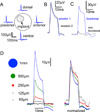Performance of photovoltaic arrays in-vivo and characteristics of prosthetic vision in animals with retinal degeneration
- PMID: 25255990
- PMCID: PMC4375097
- DOI: 10.1016/j.visres.2014.09.007
Performance of photovoltaic arrays in-vivo and characteristics of prosthetic vision in animals with retinal degeneration
Erratum in
- Vision Res. 2015 Dec;117():137. Galambos, Ludwig [Added]
Abstract
Loss of photoreceptors during retinal degeneration leads to blindness, but information can be reintroduced into the visual system using electrical stimulation of the remaining retinal neurons. Subretinal photovoltaic arrays convert pulsed illumination into pulsed electric current to stimulate the inner retinal neurons. Since required irradiance exceeds the natural luminance levels, an invisible near-infrared (915 nm) light is used to avoid photophobic effects. We characterized the thresholds and dynamic range of cortical responses to prosthetic stimulation with arrays of various pixel sizes and with different number of photodiodes. Stimulation thresholds for devices with 140 μm pixels were approximately half those of 70 μm pixels, and with both pixel sizes, thresholds were lower with 2 diodes than with 3 diodes per pixel. In all cases these thresholds were more than two orders of magnitude below the ocular safety limit. At high stimulation frequencies (>20 Hz), the cortical response exhibited flicker fusion. Over one order of magnitude of dynamic range could be achieved by varying either pulse duration or irradiance. However, contrast sensitivity was very limited. Cortical responses could be detected even with only a few illuminated pixels. Finally, we demonstrate that recording of the corneal electric potential in response to patterned illumination of the subretinal arrays allows monitoring the current produced by each pixel, and thereby assessing the changes in the implant performance over time.
Keywords: Prosthetic vision; Rat; Subretinal implant; Visually evoked potentials.
Copyright © 2014 Elsevier B.V. All rights reserved.
Figures







References
-
- Zrenner E. Fighting Blindness with Microelectronics. Science Translational Medicine. 2013;5(210):210ps16. - PubMed
-
- Wilke R, et al. Spatial Resolution and Perception of Patterns Mediated by a Subretinal 16-Electrode Array in Patients Blinded by Hereditary Retinal Dystrophies. Investigative Ophthalmology & Visual Science. 2011;52(8):5995–6003. - PubMed
Publication types
MeSH terms
Grants and funding
LinkOut - more resources
Full Text Sources
Other Literature Sources

